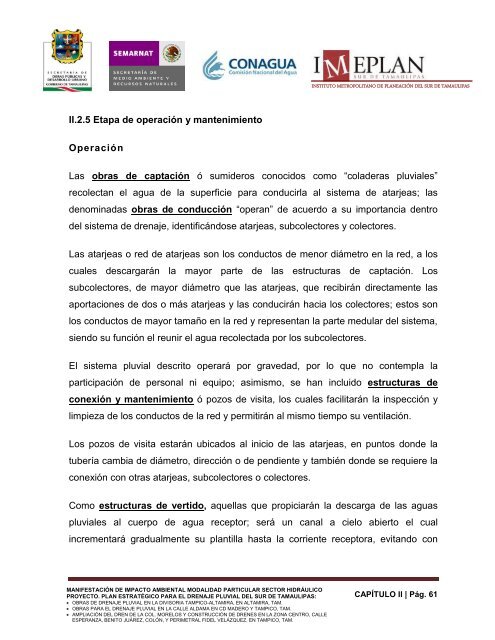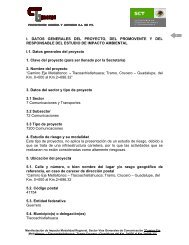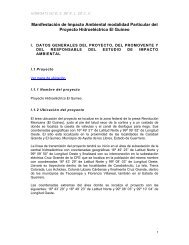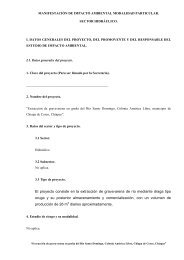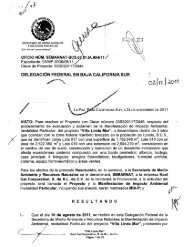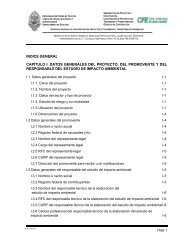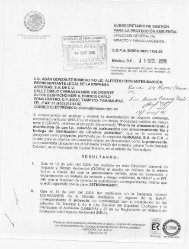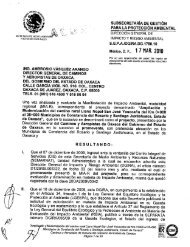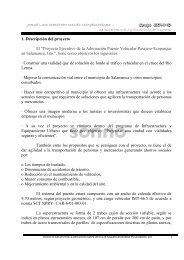plan estratégico para el drenaje pluvial del sur de ... - sinat - Semarnat
plan estratégico para el drenaje pluvial del sur de ... - sinat - Semarnat
plan estratégico para el drenaje pluvial del sur de ... - sinat - Semarnat
You also want an ePaper? Increase the reach of your titles
YUMPU automatically turns print PDFs into web optimized ePapers that Google loves.
II.2.5 Etapa <strong>de</strong> operación y mantenimiento<br />
Operación<br />
MANIFESTACIÓN DE IMPACTO AMBIENTAL MODALIDAD PARTICULAR SECTOR HIDRÁULICO<br />
PROYECTO. PLAN ESTRATÉGICO PARA EL DRENAJE PLUVIAL DEL SUR DE TAMAULIPAS:<br />
OBRAS DE DRENAJE PLUVIAL EN LA DIVISORIA TAMPICO-ALTAMIRA, EN ALTAMIRA, TAM.<br />
OBRAS PARA EL DRENAJE PLUVIAL EN LA CALLE ALDAMA EN CD MADERO Y TAMPICO, TAM.<br />
AMPLIACIÓN DEL DREN DE LA COL. MORELOS Y CONSTRUCCIÓN DE DRENES EN LA ZONA CENTRO, CALLE<br />
ESPERANZA, BENITO JUÁREZ, COLÓN, Y PERIMETRAL FIDEL VELÁZQUEZ, EN TAMPICO, TAM.<br />
INSTITUTO METROPOLITANO DE PLANEACIÓN DEL SUR DE TAMAULIPAS<br />
Las obras <strong>de</strong> captación ó sumi<strong>de</strong>ros conocidos como “cola<strong>de</strong>ras <strong>pluvial</strong>es”<br />
recolectan <strong>el</strong> agua <strong>de</strong> la superficie <strong>para</strong> conducirla al sistema <strong>de</strong> atarjeas; las<br />
<strong>de</strong>nominadas obras <strong>de</strong> conducción “operan” <strong>de</strong> acuerdo a su importancia <strong>de</strong>ntro<br />
d<strong>el</strong> sistema <strong>de</strong> <strong>drenaje</strong>, i<strong>de</strong>ntificándose atarjeas, subcolectores y colectores.<br />
Las atarjeas o red <strong>de</strong> atarjeas son los conductos <strong>de</strong> menor diámetro en la red, a los<br />
cuales <strong>de</strong>scargarán la mayor parte <strong>de</strong> las estructuras <strong>de</strong> captación. Los<br />
subcolectores, <strong>de</strong> mayor diámetro que las atarjeas, que recibirán directamente las<br />
aportaciones <strong>de</strong> dos o más atarjeas y las conducirán hacia los colectores; estos son<br />
los conductos <strong>de</strong> mayor tamaño en la red y representan la parte medular d<strong>el</strong> sistema,<br />
siendo su función <strong>el</strong> reunir <strong>el</strong> agua recolectada por los subcolectores.<br />
El sistema <strong>pluvial</strong> <strong>de</strong>scrito operará por gravedad, por lo que no contempla la<br />
participación <strong>de</strong> personal ni equipo; asimismo, se han incluido estructuras <strong>de</strong><br />
conexión y mantenimiento ó pozos <strong>de</strong> visita, los cuales facilitarán la inspección y<br />
limpieza <strong>de</strong> los conductos <strong>de</strong> la red y permitirán al mismo tiempo su ventilación.<br />
Los pozos <strong>de</strong> visita estarán ubicados al inicio <strong>de</strong> las atarjeas, en puntos don<strong>de</strong> la<br />
tubería cambia <strong>de</strong> diámetro, dirección o <strong>de</strong> pendiente y también don<strong>de</strong> se requiere la<br />
conexión con otras atarjeas, subcolectores o colectores.<br />
Como estructuras <strong>de</strong> vertido, aqu<strong>el</strong>las que propiciarán la <strong>de</strong>scarga <strong>de</strong> las aguas<br />
<strong>pluvial</strong>es al cuerpo <strong>de</strong> agua receptor; será un canal a ci<strong>el</strong>o abierto <strong>el</strong> cual<br />
incrementará gradualmente su <strong>plan</strong>tilla hasta la corriente receptora, evitando con<br />
CAPÍTULO II | Pág. 61


